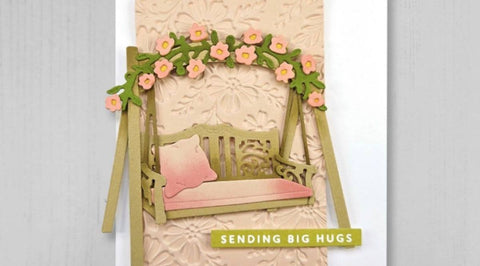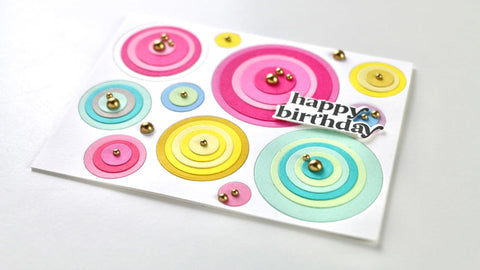Celebrate World Cardmaking Day 2024 with 5 Ink Techniques
Last Updated: October 27, 2025
As we approach World Cardmaking Day 2024, it's a wonderful reminder for all of us to slow down, get creative, and pour our hearts into making beautiful cards. For many cardmakers, this day is more than just a celebration; it's a chance to escape the daily grind and indulge in a hobby that brings joy and connection. However, we often face challenges—whether it’s struggling to find the right color palette, feeling stuck in a creative rut, or simply wishing to elevate our skills without feeling overwhelmed.

Dynamic Duo Dainty Roses Stencils
That’s where the magic of creativity comes in. Cardmaking can be an incredibly fulfilling outlet, allowing us to express our emotions and connect with loved ones through thoughtful, handmade cards.
Should I use pigment inks or dye inks for cardmaking?
In this blog post, we’ll explore five fantastic dye ink techniques that can help you overcome some common struggles in cardmaking. Let’s dive into these ink techniques together and discover how they can inspire your cardmaking journey this World Cardmaking Day!

What Are Dye Inks?
Dye inks are water-based inks known for their vibrant colors and smooth application. These inks are widely used in stamping and ink blending, making them perfect for paper crafting. They’re easy to use, dry quickly, and produce crisp images every time.
Why use dye inks in cardmaking?
- Vibrant Colors: Altenew dye inks offer a rich palette, perfect for creating eye-catching designs.
- Quick-Drying: These inks dry quickly, reducing the risk of smudging and allowing for layering without long wait times.
- Versatility: Ideal for various techniques such as stamping, watercoloring, and ink blending.
- Easy to Blend: The inks blend seamlessly, making it easy to create gradients and other effects.

Dye Inks or Pigment Inks? Which One Is the Best for You?
| FEATURE | DYE INKS | PIGMENT INKS |
| Drying Time | Quick-drying | Slow drying |
| Finish | Crisp and saturated | Opaque and vibrant |
| Application | Absorbed by paper | Sits on top of the paper |
| Water Resistance | Less water-resistant | More water-resistant |
| Best For | Stamping, blending, and layering | Permanent work, working with water-based mediums |
5 Dye Ink Techniques to Try on World Cardmaking Day 2024

Craft Your Life Project Kit: Butterfly Marigold
1. Ink blending on colored cardstock for dimension
With some layering stencils, inks, and ink blending tools, you can add instant dimension to any image. However, Jaycee took it up a notch by using coordinating colored cardstock and doing some color blocking technique. Here’s a quick step-by-step on how he created his card above.
- Stamp the image on Buttercream Cardstock using Warm Sunshine Dye Ink for a no-outline look. Die cut the image.
- Create two distinct palettes for the marigold flowers using Warm Sunshine and Caramel Toffee inks for the outer ones and Warm Sunshine and Crimson inks for the center flower. Watch each petal take on a life of its own!
- For some extra “wow” factor, stamp the outline of the marigold on the card base using Warm Sunshine Dye Ink, this time in a different orientation.
- Foam mount the die-cut cluster onto the card base.
- Add splatters using Mountain Mist Liquid Watercolor.
- Stamp the “Just A Note” sentiment in Warm Sunshine Dye Ink on white cardstock, die cut, and pop it onto the card front.

If you want to dabble in some watercolor art and practice those watercoloring skills, you can totally do that with dye inks! Therese shared 5 tips in this blog and we implore you to give them a try on your next handmade card. Here’s a simple one you can start with:
- Prepare a watercolor panel. Tip from Therese: Using Hot Pressed Watercolor Paper will make it easier if you plan to do any stamping on the finished piece, as it has a smoother finish!
- Smoosh your chosen ink colors onto a non-porous surface such as a palette and pick up the ink with a paintbrush dipped in water. Therese used Puffy Heart and Sunray Fresh Dye Inks.
- Place the first layer of the stencil on the card base. Tip from Therese: Use a Sticky Mat to hold stencils in place while coloring. This decreases the chance of tearing the cardstock when removing masking tape.
- Start splattering away with both ink colors.
- Use the smooshed dye inks to watercolor through the next layers.

Floral Engravings Press Plate/Foil Plate
3. Ink debossing with a letterpress plate
Have you tried debossing with a letterpress plate? How about ink debossing with a letterpress plate? Well, have you tried using various dye ink colors for this technique? You definitely should! In his card above, Jaycee added a unique twist by experimenting with different dye inks to create a custom palette.

Build-A-Flower: Semi-Double Chrysanthemum
4. Adding subtle texture and depth through ink blending
There are so many ways to add pizzazz to ink blended images. We promise you won’t ever get bored of all the ink blending techniques we’re sharing today. For instance, Laurie white-heat embossed her chrysanthemum images a few times, blended ink all around the panel, and then added a slightly darker ink in the flower centers for that subtle texture and depth.

Here’s another tutorial by Lydia—different technique, same fabulous result!

Craft-A-Flower: Hibiscus Layering Die Set
5. Watercolor and ink blend for a pop of vibrant color
If you really want to make your images pop off the page, then this tutorial by Erum is for you! She watercolored the images from Craft-A-Flower: Hibiscus Layering Die Set first. Once the die-cuts were dry, she started blending inks to parts of the hibiscus and leaves where she wanted that “extra pop” of colors.

Ink Blending to Create Faux Dimension
Here’s another must-try ink blending tutorial from Erum where she added faux dimension by adding darker inks and using a Fine Liner Pen.
Other easy ink techniques for cardmaking you need to try!
If you’re looking to add some flair to your cardmaking, there are a few easy ink techniques that can really bring your designs to life!

- Watercolor Wash. This technique gives you that soft, dreamy background that’s perfect for any card. To start, mix your favorite dye ink with a bit of water on a palette. Grab a large brush and gently sweep the color across your cardstock, letting the water do its magic. For the best results, work in layers—apply one layer, let it dry, and then add another for depth. It’s a simple yet stunning way to create beautiful backdrops.

- Ombre Effect. This one is all about creating a gorgeous gradient from light to dark. You’ll need a few shades of the same color family and a blending tool. Start by applying the lightest shade at one end of your card, then gradually blend in the darker shades, overlapping them slightly. The key is to go slow and take your time to achieve that seamless transition. It adds such a lovely depth to your cards and can really make your designs pop!
- Resist Techniques. This fun method involves using clear embossing powder to create designs that resist ink. First, stamp your image and cover it with clear embossing powder, then heat it until it’s set. Once it cools, apply your dye ink over the entire surface. The embossed areas will resist the ink, creating a beautiful contrast. You can get really creative with this—try using floral patterns, fun shapes, or even inspirational quotes to make your cards uniquely yours. Each of these techniques is easy to learn and can open up a world of creative possibilities for your cardmaking journey!

Celebrate World Cardmaking Day 2024 with These Easy Dye Ink Techniques
World Cardmaking Day is not just a fun day to celebrate the art of cardmaking. It’s also a day to embrace creativity and enjoy the benefits of creating something with your hands. Whether you’re crafting solo or with friends, these 5 dye ink techniques are perfect for your next crafting session. On October 5th, we invite you to explore other cardmaking ideas, read blogs, watch tutorials, and most importantly, MAKE CARDS! We’d love to see your handmade cards so make sure to tag us (@altenewllc) when you post them. Happy World Cardmaking Day 2024!
ChatGPT said:















